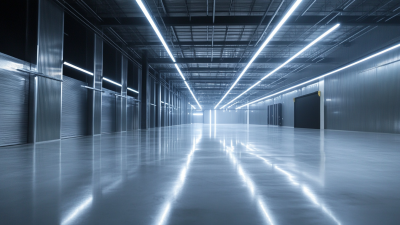Edison LED Lighting
Projects
Transform Your Space: The Science and Benefits of Linear Lighting Explained
In recent years, Linear Lighting has emerged as a pivotal trend in architectural design, transforming both residential and commercial spaces with its sleek, modern aesthetic. According to a report from the American Lighting Association, there has been a significant increase in the demand for linear lighting solutions, with a projected growth rate of 10.5% annually through 2025. This innovative lighting technique not only enhances the visual appeal of a space but also improves functionality, offering a well-distributed and uniform illumination that can boost productivity and mood. Additionally, studies show that well-lit environments can increase focus by up to 15% and reduce energy costs by 30% when compared to traditional lighting options. As we explore the science and benefits of Linear Lighting, we uncover how these versatile fixtures can revolutionize your space, blending style with sustainability.

Understanding Linear Lighting: The Basics and Key Components
Linear lighting has emerged as a versatile and efficient lighting solution in both residential and commercial spaces. At its core, linear lighting systems consist of a series of light fixtures connected in a continuous linear format, often featuring LED technology. According to a report by the U.S. Department of Energy, LED lighting can save up to 75% in energy consumption compared to traditional incandescent bulbs, making linear lighting not only an aesthetically pleasing option but also a sustainable one.
Key components of linear lighting include the light source, fixture design, and the control systems that govern brightness and color temperature. Fixtures designed for linear lighting come in various forms, such as recessed, surface-mounted, or suspended options, allowing for flexible installation based on architectural needs. A study by the Lighting Research Center indicates that quality linear lighting can improve workplace productivity by up to 20%, as it provides even illumination and reduces glare. This adaptability makes linear lighting ideal for environments ranging from offices to retail spaces, helping to create inviting atmospheres while enhancing functionality.
Transform Your Space: The Science and Benefits of Linear Lighting
This bar chart illustrates the key benefits of linear lighting in various settings, showcasing how it enhances aesthetics, functionality, and energy efficiency in spaces.
The Science Behind Linear Lighting: How Light Impacts Your Space
Linear lighting has emerged as a pivotal design element in contemporary spaces, driven by scientific insights into how light influences human behavior and perception. Research indicates that the quality and distribution of light can significantly affect mood, productivity, and overall well-being. For instance, a study by the Illuminating Engineering Society found that a well-lit environment can increase work efficiency by up to 20%, highlighting the essential role of lighting design in workplaces.
When considering linear lighting, it's essential to understand how the placement and intensity of light can shape an environment. For instance, brighter, more focused linear lighting can enhance attention to detail in areas such as kitchens or study spaces. In contrast, softer, warmer linear lights can create a more relaxed atmosphere in living areas or bedrooms. By strategically utilizing different types and placements of linear lighting, designers can foster spaces that not only look appealing but also promote healthier living and working conditions.
**Tips:**
1. Incorporate dimmable options to adjust lighting based on the time of day or activity.
2. Use color temperature strategically; cooler lights (above 4000K) can invigorate workspaces, while warmer lights (below 3000K) are ideal for relaxation zones.
3. Consider layering your lighting with linear fixtures to create depth and dimension in your space.

Exploring Design Options: Creating Ambiance with Linear Lighting
Linear lighting is a versatile design choice that can dramatically alter the atmosphere of a space. By integrating linear fixtures into your interior design, you can create various ambiances, from sleek and modern to warm and inviting. The even diffusion of light provided by linear sources helps to eliminate harsh shadows, making spaces feel more open and airy. This lighting style is particularly effective in areas like kitchens, hallways, and commercial settings, where clarity and aesthetic appeal are essential.
**Tips:** When planning your linear lighting, consider the height and placement of fixtures to optimize the light spread. Using dimmers can also help you adjust the mood; brighter settings are perfect for tasks, while lower brightness creates a cozy vibe for relaxation. Don’t hesitate to mix linear lights with other lighting types, like accent or ambient lighting, to enhance depth and visual interest in your design.
Additionally, selecting fixtures with adjustable color temperatures can allow you to change the mood of a space instantly. Cooler tones may invigorate a workspace, while warmer tones invite comfort in living areas. Be mindful of the materials and finishes in your lighting fixtures, as these can complement or contrast with your overall design theme, adding another layer of detail to your ambiance.
Health and Well-being: The Psychological Benefits of Linear Lighting
Linear lighting has become increasingly popular in modern interior design, not just for its aesthetics, but also for its psychological benefits. The long, continuous lines of light create a sense of calm and order in a space, which can significantly influence our mood and behavior. Studies show that well-lit environments can enhance concentration and productivity, making linear lighting an ideal choice for offices and study areas. The even distribution of light reduces shadows and eliminates harsh contrasts, contributing to a more soothing atmosphere.

Moreover, linear lighting can positively impact our well-being by mimicking natural light. This kind of lighting helps regulate our circadian rhythms, promoting better sleep at night and increased alertness during the day. The psychological benefits extend to personal spaces as well, where the gentle illumination fosters relaxation and comfort. By incorporating linear lighting into homes and workplaces, we not only enhance the aesthetic appeal but also create environments that nurture mental health and overall well-being.
Installation Tips and Best Practices for Linear Lighting Systems
When considering linear lighting systems, understanding installation tips and best practices is crucial for achieving optimal results. Proper placement and alignment are essential, as these systems can dramatically enhance the aesthetics and functionality of a space. Consider integrating the lighting fixtures along pathways, ceilings, or under cabinets to create a seamless and modern look that not only illuminates but also complements the interior design. Additionally, ensure that the electrical installation complies with the National Electrical Code (NEC) guidelines to guarantee safety and reliability.
Another significant aspect is selecting the right type of linear lighting, such as LED, which has proven to improve workplace safety by reducing the risk of accidents. Opting for energy-efficient solutions not only lowers electricity costs but also contributes to a sustainable environment. Familiarizing yourself with the technical specifications and compatibility with smart lighting systems can elevate your experience, allowing for greater control and flexibility in your lighting design.
Transform Your Space: The Science and Benefits of Linear Lighting Explained
| Feature | Description | Benefits | Installation Tips |
|---|---|---|---|
| Light Quality | Linear lighting produces high-quality, even illumination. | Reduces shadows and creates a pleasant visual environment. | Ensure correct spacing between fixtures for optimal light distribution. |
| Energy Efficiency | Uses LED technology for lower energy consumption. | Lowers utility bills and reduces carbon footprint. | Use motion sensors and dimmers for better energy management. |
| Design Flexibility | Available in various lengths, colors, and designs. | Customizable to fit any space and aesthetic. | Incorporate linear lighting into architectural features for impact. |
| Installation Ease | Simple installation processes with various mounting options. | Minimizes disruption and installation time. | Follow manufacturer guidelines and use proper tools for a secure fit. |
Related Posts
-

Unlocking the Advantages of Best Linear Lighting for Global Procurement Success
-

Navigating the Future of Best Linear Lighting Trends for Global Buyers in 2025
-

Exploring the Efficiency of Linear Lighting Solutions Against Traditional Alternatives
-

What is the Future of Best LED Down Lights? Insights and Trends for Global Buyers
-

Crafting Global Trust Through Unmatched Quality: The Rise of Chinese Shop Lighting
-

Essential Checklist for Optimizing Your Shop Lighting to Boost Sales and Efficiency
